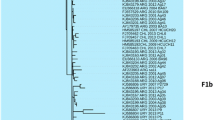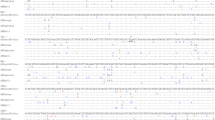Summary.
Seven human hepatitis B virus (HBV) genotypes have been described. Genotype F, indigenous to the Americas, is the most diverging group. Our in-depth analysis of the genetic distances of this genotype included ten Argentine samples. Phylogenetic analysis on the small (S) gene of the surface antigen showed four different clusters within genotype F, which were associated with a well-defined geographical origin. Even closely connected sequences sharing a common ancestor had shown some characteristics or markers indicating geographical differentiation. Nucleotide sequences and amino acids translated according to the polymerase open reading frame (P-ORF), rather than S-ORF, yielded a more discriminating analysis.
Similar content being viewed by others
Author information
Authors and Affiliations
Additional information
Accepted April 20, 2001 Received January 16, 2001
Rights and permissions
About this article
Cite this article
Mbayed, V., Barbini, L., López, J. et al. Phylogenetic analysis of the hepatitis B virus (HBV) genotype F including Argentine isolates. Arch. Virol. 146, 1803–1810 (2001). https://doi.org/10.1007/s007050170066
Issue Date:
DOI: https://doi.org/10.1007/s007050170066




